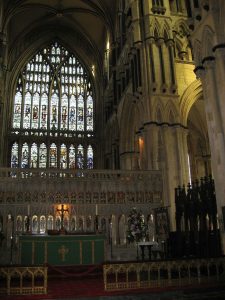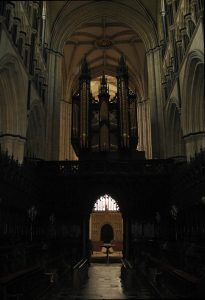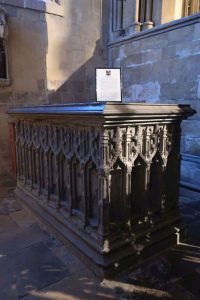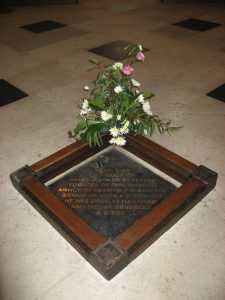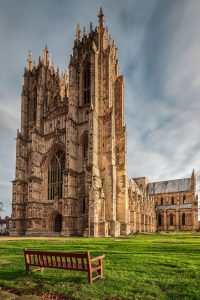The borough of Beverley and its pre 1832 parishes of St. John (better known as the Minster), St. Mary, St. Nicholas and St. Martin were situated in what was once the Hunsley Beacon division of the Harthill wapentake, part of the historical East Riding of Yorkshire (see maps in Introduction) along with the subparishes of Aike, Beverley Parks, Eske, Grove Hill, Hull Bridge, Molescroft, Stork Hill, Thearne, Tickton, Weel and Woodmansey.
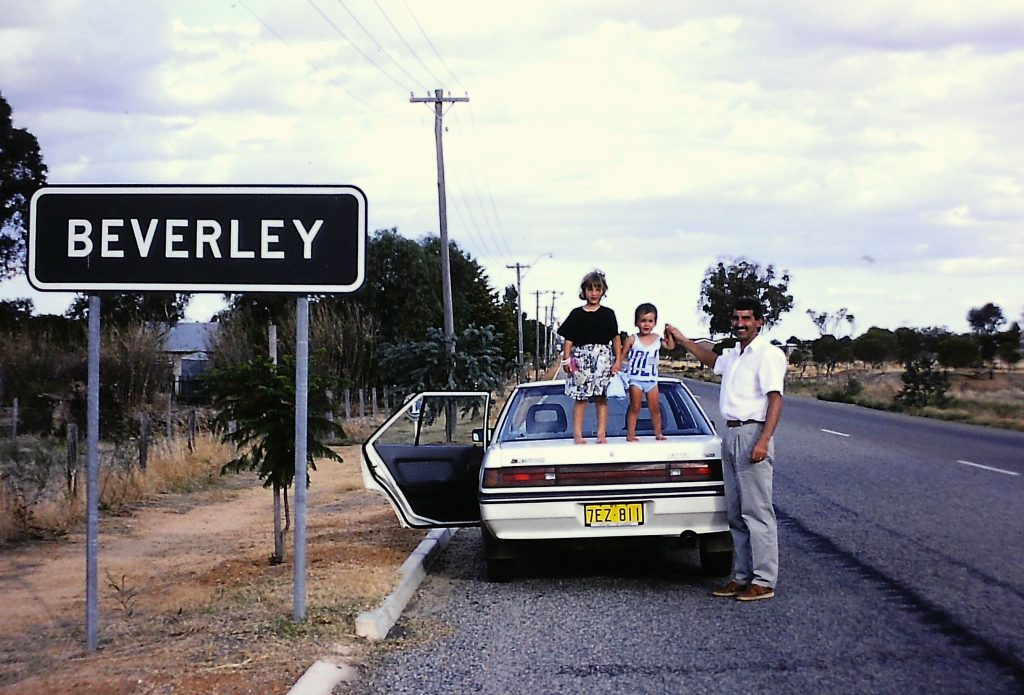
Beverley lies on the spring line at the foot of the dip slope of the Yorkshire Wolds, above the once marshy flood plain of the river Hull. This higher ground proved attractive to men from an early date, and Beverley Westwood, the common pasture to the west of the town, is the site of several Iron Age barrows and of other earthworks which may belong to the same period. Further earthworks have been identified as Romano-British.
The beavers that inhabited the marshland, which was later drained and where the Minster was built, gave the borough its name (“beaver meadow”). It inspired the naming of the city of Beverly, Massachusetts, which in turn was the impetus for Beverly Hills, California. By the 1950s Beverley council was able to send official greetings to three Beverleys in the Commonwealth.
Origins
The earliest foundation of what became the collegiate church of St. John the Evangelist is said to have been in the time of King Lucius, towards the middle of the 2nd century. It was destroyed by Saxon infidels in c450, restored and dedicated to St. John, converted into a monastery by Bishop John of York (1) in c714 and reconstituted as a collegiate church by King Athelstan. Nothing is known of Bishop John’s monastery, though archaeological evidence of 8th century settlement in the area where the Minster was later built lends some credence to its site, nor can it be proved that the monastery in which Bishop John was buried in 721 was at Beverley. Bede, a contemporary of the Bishop, calls it Inderawuda (in silva Deirorum) which tells us no more than it was situated ‘in the wood of the men of Deira’, and history tells us only that the Saxons destroyed a Romano-British church in the area. Athelstan was regarded throughout the Middle Ages as the real founder of the college.
Following the defeat of the Vikings at York in 927, King Athelstan invaded Scotland with a large military and naval force in 934, harassing the Scottish army up to Kinkardineshire and the navy up to Caithness. Battle was never engaged but King Constantine II of Scotland allied with his former enemies, King Olaf Guthfrithson of Dublin and King Owain of Strathclyde, to put an end to the English threat. On his march north in 937 King Athelstan is said to have visited Bishop John’s tomb and, following his decisive defeat of the alliance at the battle of Brunanburh (2), reputedly gave the credit for his victory to him. Before his death in 939 he showed his gratitude by establishing a college of secular canons at Beverley, endowing it generously with land and privileges, including the creation of a sanctuary extending for a mile around Bishop John’s tomb and the right of the Minster to receive a levy of corn throughout the East Riding.
The account of Athelstan’s role, however, dates from the 12th century, and it is likely that the establishment of the Minster and its rights was a more gradual process, retrospectively credited to a single royal benefactor for the sake of the security and prestige conferred by such a founder. The final formalisation of the Minster’s position may not have been achieved until the 11th century, when major rebuilding of the Minster itself and its associated buildings took place, together with a regularisation of the communal life. It also brought the first recorded royal charter to Beverley, that of Edward the Confessor (reigned 1042-1066), which declared the Archbishop of York the town’s sole lord under the king.
In 1037 Archbishop Aelfric secured the canonisation of Bishop John as St. John of Beverley and oversaw his translation to a magnificent new shrine. It was the identification of Beverley with his cult which allowed it to become a major centre, and the presence of his shrine helps to explain the immunity of the town from the worst consequences of the “harrying of the north” by William the Conqueror in 1069-70. A mid 12th century compilation of the miracles of the saint shows that his tomb was drawing visitors not only from Yorkshire and Lincolnshire, but also from East Anglia and Scotland. Royal respect for St. John was strengthened by the attribution of military powers to him and his banner. The first known reference to the banner’s use in battle was at the battle of the Standard (3) in 1138. By 1266 it was accepted that when the shire of York was summoned to the royal army, the church of Beverley would send one man with the saint’s banner. Edward I had the banner with him on his Scottish campaigns of 1296 and 1300, and the king showed his gratitude by establishing a chantry in the Minster in honour of St. John. Edward II, Edward III and Henry IV also received the protection of the banner. In 1415 St. John’s reputation received a further boost when the victory of Agincourt was won on the feast of his translation (25 October). Henry V visited the shrine during his progress of 1420, and Henry VI spent a week in Beverley in 1448 on what was to be his only progress to the north.
Administration
The Archbishop of York, as sole lord under the king, was the beneficiary of the cult of St. John, and this was confirmed by later kings. This became a perennial source of grievance for the people of Beverley throughout the Middle Ages, access to land and game being the most contentious matters. Even when the townspeople’s claims against the archbishop were upheld, the latter often rejected the verdicts and excommunicated those involved. His lordship and the rights and privileges exercised by his officers and those of St. John’s college came to a head in 1534, when a group of malcontents sought to gain control of the administration of the town. Their ringleader was Sir Ralph Ellerker of Risby, in the parish of Rowley. He bought a house in the town to qualify him for election and in 1534 he was nominated a governor. Beverley took a significant move towards self-determination when in 1542 the crown acquired the town from Archbishop Lee in return for a grant of property elsewhere, and the crown’s officers replaced those of the archbishop. In 1573, in response to a request by the burgesses and at a cost to the town of £223, Beverley was finally incorporated by royal charter under the mayor, governors and burgesses. The first mayor was Edward Ellerker, great-grandson of the rebellious Sir Ralph. During the same period another ecclesiastical franchise endured by the townspeople, that of the provost, was removed with the suppression of the college in 1548 during the Reformation.
Representation in parliament, which Beverley had enjoyed briefly c1300 during the war against Scotland, was resumed in 1563 and confirmed at incorporation, when the two members were elected. Sir Christopher Hildyard was elected MP in 1621 and Sir John Hotham of Scorborough, baronet, and Sir William Alford of Meaux in 1625. The structure of the government as laid down by a further charter of 1685 remained essentially unchanged until 1835, though the right to elect its two MPs evidently passed from the corporation to the whole body of freemen in the late 17th century.
The Minster
The term Minster originally designated any settlement of clergy living a communal life and endowed by charter with the obligation of maintaining the daily office of prayer. It derives from the Latin monasterium and is therefore in keeping with the conversion of the original place of worship into a monastery by Bishop John of York. A 12th century charter indicates substantial rebuilding work on the church following the latter’s canonisation in 1037. A high stone tower and a new presbytery were added, with a painted and gilded ceiling linking the two. Nothing remains of this Anglo-Saxon church, and no records of building work under the Normans survive, though Norman arches were reused as building materials in the nave and in the south choir aisle. A fire in 1188 seriously damaged much of the church so that complete rebuilding was required. The whole of the eastern part, including the first bay of the nave westward of the central tower, the two eastern transepts, the choir and the two great transepts are Early English Gothic, dating back to c1225 to c1250. Of this building campaign, only the chapter house was lost, although its wonderful staircase survives in the north choir aisle. A new shrine for St John of Beverley was ordered in 1292, to which the saint’s remains were translated on 25 October 1307, and the following year Archbishop Greenfield dedicated the new high altar in his honour. The nave, as far as the extreme western bay, dates back to the period 1308 to 1347, perhaps beyond, and is Decorated Gothic.
In 1307 a charter of ordination of a chantry enabled Robert of Pickering (4), canon and prebendary of St. Peter’s altar, to grant the rent of eight shops built on his prebend as a stipend to a chaplain “to celebrate daily for the good estate of me, Archbishop William Greenfield, my brother Master Wm. Pickering, Archdeacon of Nottingham; and the souls of my father, mother, brother Adam, sister Cecilia, my predecessors and successors, and those of the Archbishops of York and Canons of York and Beverley, and all Christian souls and after our deaths for our souls and all those abovesaid”.
A period of more than half a century separates the end of the 13th century work carried out on the Minster from that of the 14th, so that to the trained eye they are easily distinguishable. Yet care was taken to assimilate the two, so to the untrained eye it requires close observation to detect the change of style, hence Leland’s remark that Beverley Minster is “of a fair uniform making”. The later work preserved the general effect though the arches and windows were enlarged to allow for more generous lighting. By the early 15th century, with the addition of the Perpendicular Gothic west front flanked by two magnificent towers and the building of the north porch, the Minster was structurally complete. The only major later works were the great east window (funded by a bequest in 1416), the chapel built by the Percys in c1490 to house the tomb of the 4th Earl of Northumberland, and the choir stalls (c1520).
Following the dissolution of the monasteries and the English Reformation, in 1578 the Minster was reduced to the status of a parish church, the college of secular canons was dissolved and the shrine of St John was dismantled. The chapter house, now unused, was demolished. By the early 17th century the parish church of St Martin, formerly attached to the three southwestern bays of the nave, was also gone. By the early 18th century the church was in a state of decay. Flying buttresses reinforced the stone vaulting in all areas except on the north transept, and by 1700 it was in a state of near collapse. Major restoration took place from 1717 to 1731.
After the suppression of the college one of the vicars choral was appointed vicar of the parish, the grammar school was continued under a head master and the lands of the church came into the hands of various grantees of the crown. Edward VI and Queen Elizabeth made large grants to the corporation of Beverley, who were constituted patrons of the church. The patronage was later vested in the archbishop until the purchase of the advowson of the vicarage by the trustees of the Rev. Charles Simeon.
St. Mary’s church
St Mary’s was established in the first half of the 12th century as a daughter church of the Minster to serve Beverley’s trading community. The church is cruciform in shape, and the 12th and early 13th century fragments that remain attest to it having had an aisleless chancel and transepts, an aisled nave and probably a crossing tower. Major rebuilding began in the late 13th century during the Decorated Gothic period, when the church was enlarged, and the west front was rebuilt in the Perpendicular Gothic style c1400. Further building and rebuilding followed in the mid 15th century, when the Early English Gothic arches were reused but set on new piers. A series of fine wooden ceilings, for which the building is renowned, were installed throughout the 15th and into the 16th centuries. During Evensong on 29 April 1520 the central tower collapsed. It was entirely rebuilt, along with the adjacent parts which had suffered collateral damage. In the 19th century significant restoration was again undertaken.
Manors
There were two manors at Beverley. Besides the borough itself, Beverley Water Towns manor included Sicey, Sneerholmes, Stork, Thearne, Tickton, Weel and Woodmansey. It belonged to the archbishop until 1542, when he exchanged it with the crown. After the suppression of St. John’s college in 1548 much of its former property in Beverley and elsewhere was retained by the crown as the manor of Beverley Chapter. Over the centuries both manors passed through multiple hands.
Economic and social life
In the Middle Ages Beverley stood high among the provincial towns of England in terms of size and, until the rise of Hull at the end of the 13th century, Beverley was the trading centre of the region. Its role grew naturally out of the town’s importance as a religious centre, and was also fostered by the archbishops of York who were responsible for obtaining royal charters for markets on the town’s behalf.
The archbishops also encouraged waterborne trade. The river Hull that flows east of the town provided a link with the Humber and the port of Hull, some eight miles to the south. Archbishop Giffard (1266-79) was active in attempts to keep the Hull navigable, persuading local landowners to release their rights in the river. His most important agreement was with Joan de Stuteville, lady of Cottingham manor, who undertook to remove all her weirs from the river in return for an annual rent of £4 payable to herself and her heirs. Unimpeded passage along the river benefited the archbishop, as the recipient of tolls on riverborne trade, but it also benefited the town, which reimbursed him for the rent. However, the river Hull was a mile from the town and it was necessary to carry goods by road to and from the staithe at Grovehill. By the end of the 13th century one of the watercourses which drained from the Wolds into the river, later known as Beverley beck, had become the recognised water route into the suburbs. Coal, corn, salt and wine were among the goods carried between the Beverley and Hull by common carriers and watermen.
The town’s prosperity from the 12th to the 14th century depended heavily on the wool trade. Raw wool was exported to the cloth towns of the Low Countries, and Flemings were already trading in Beverley in the 12th century, giving their name to Flemingate. Beverley merchants in turn established European bases in Bruges and Calais. The trade also attracted English newcomers to the town, not only families bearing surnames from Holderness and the Wolds, but also families from places further afield like Lincolnshire, Bristol, Carlisle, Westmorland and Winchester. After a peak in the 1350s the export of wool had slumped dramatically by the 15th century, but this was partly offset by a growth in the export of cloth. Beverley had already made a name for itself as a producer of good quality cloth, supplying burnets, coloureds, and blues to the king and scarlets to Spanish merchants. However, a decline in the cloth trade followed that of the wool trade, quickened by the suppression of St. John’s college and the ensuing neglect by the crown and lay owners of the former possessions of the religious houses. Tanning and brick making, the town’s other main economic activities, were not important enough to fill the gap. Vacant houses and plots were repeatedly mentioned in the 1530s, and Beverley was included in the Act of 1540 for the rebuilding of towns.
In the 17th century Beverley’s economy was based on the processing of agricultural products, especially malting, oatmeal making and tanning, together with some corn milling. Brick making also continued. The twice weekly markets and the fairs began to play a prominent part in the town’s economic life, and by the closing decade of the century the type of occupations suggest a greater measure of prosperity. The corporation welcomed militia musters which brought in customers, and took measures to make Beverley more attractive to prosperous farmers, professional men and gentry by supporting such social activities as a bowling and horse racing.
The town’s prosperity in the 18th century and the early 19th came not only from its position as the principal trading and processing centre for a wide agricultural area but also from its recently acquired role as the administrative centre of the East Riding and its related function of supplying entertainment and services for local landowning families. Tanning remained prominent, as was woodworking, in particular cabinet making and shipbuilding, and the number of shipwrights and carpenters rose during the Napoleonic Wars. The growth of the town as a social and residential centre led to a marked increase in the number and range of retail shops (grocers, drapers and mercers) and specialist services. In the early 18th century Beverley had a goldsmith, a silversmith, a coppersmith, a coach maker, a gunsmith, a cutler, a wig maker and a tobacconist, as well as booksellers, watchmakers, scriveners, translators, dancing masters and numerous musicians. The law and medicine professions were also well represented. At the start of the period Beverley was still largely confined within its medieval boundaries and much of the growing population was housed in closely built-up lanes and yards behind the existing streets. In contrast, the houses of the gentry and professional population occupied substantial sites both within the built-up area and on its fringes.
The boom years of the early 1790s gave way to a decline in trading in the second decade of the 19th century, and by the early 1830s there were signs of a marked change in the economy of the town. By the mid 1830s Beverley was no longer a gentry town and its social climate had changed considerably; it had become predominantly a middle-class professional town with a growing industrial population. At the end of the century the picture was much the same. The traditional industries remained prominent: grain milling, tanning, shipbuilding, to which ironworking had been added by 1825. Of the lesser industries several were concerned with processing agricultural produce or making goods for agricultural use. The designation of Beverley as the county town of the East Riding in 1892 and the completion of new barracks in 1877 for the East Yorkshire Regiment helped to augment a professional and prosperous middle class. A new grammar school for boys and a public library were built and a girls’ high school founded. Despite this and in response to the growing population, there was substantial emigration throughout the period 1835–1918. In 1906 the Beverley Emigration Society made plans to send a group of men to Canada annually, and a party of fifty left that year.
The industrial life of Beverley in the period 1918-1945 was marked by the decline in the old-established industries. These included brewing, seed crushing, brick making, the manufacture of agricultural implements, fertilizer manufacture, ship building and tanning. Some survived, on a reduced scale (fertilizer manufacturing and shipbuilding) and in a different form (glue and gelatine production instead of tanning and animal feedstuff manufacture instead of seed crushing). In 1907 a new industry came to Beverley when George Armstrong opened a garage and workshop at North Bar Within for the production of cars. During the First World War he concentrated on munitions and tractors, and in the interwar years on shock absorbers, which became the company’s mainstay. In 1925 Charles Deans of Hull, manufacturer of musical instruments and later motor vehicle and furniture components set up in Beverley.
Post-war Beverley became an increasingly popular middle-class residential town owing to the growth of motor transport which facilitated commuting between Hull and Beverley. However, the prosperity the town enjoyed in the early 1970s came to an end when its industry was shattered by the 1973 oil crisis. One effective counter measure was the enlargement of the role of Beverley as an administrative centre, and another was the development of tourism.
Pickerings in Beverley
Pickerings were paying poll tax in Beverley 1381, and they are well represented in the parish registers of the Minster and St. Mary’s from their beginning in the mid 1500s.
(1) Bishop John is said to have been born in Harpham.
(2) The location of the battlefield has been the subject of lively debate among historians since at least the 17th century. One purported site is Little Weighton.
(3) see Brus / Bruce family, 3rd paragraph
(4) Master Robert de Brus of Pickering (see Brus / Bruce family, 9th Generation)
Sources:
https://www.genuki.org.uk/big/eng/YKS/ERY/Beverley
https://en.wikipedia.org/wiki/Beverley
https://opendomesday.org/place/TA0339/beverley
Victoria History of the County of York, East Riding, vol. 6, Borough and liberties of Beverley: https://www.british-history.ac.uk/vch/yorks/east/vol6
https://en.wikipedia.org/wiki/Minster_(church)
https://en.wikipedia.org/wiki/Beverley_Minster
Introduction to The Chapter Act Book of the Collegiate Church of S. John of Beverley: https://archive.org/details/memorialsbeverl02leacgoog/page/n9
The Minster Church of St. John: https://historicengland.org.uk/listing/the-list/list-entry/1084028?section=official-list-entry
https://en.wikipedia.org/wiki/St_Mary%27s_Church,_Beverley
The Parish Church of St Mary: https://historicengland.org.uk/listing/the-list/list-entry/1162693?section=official-list-entry

